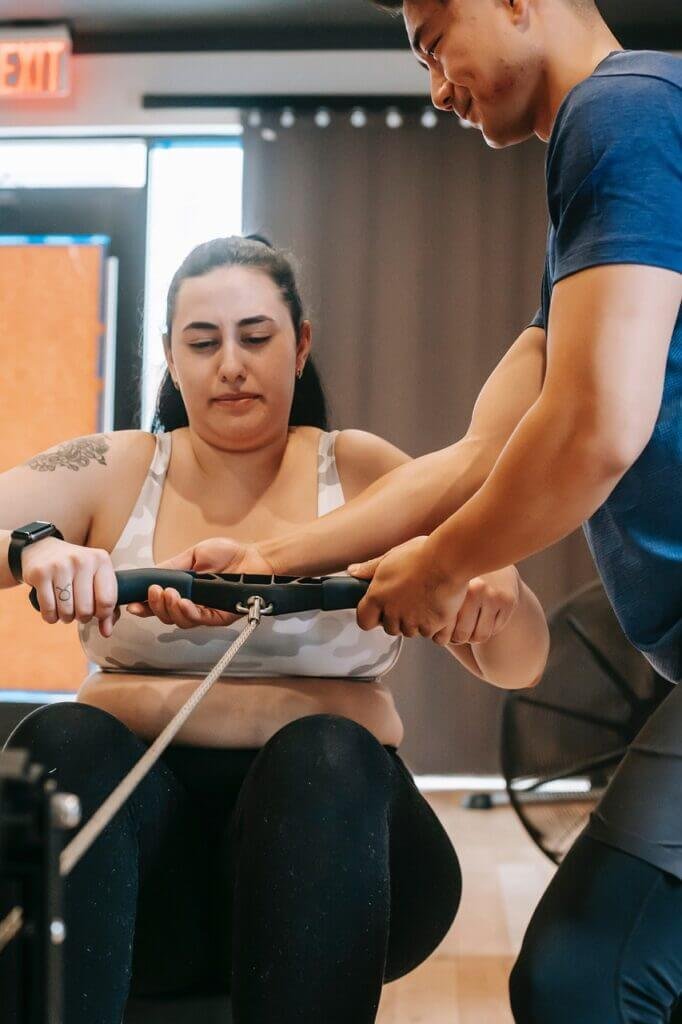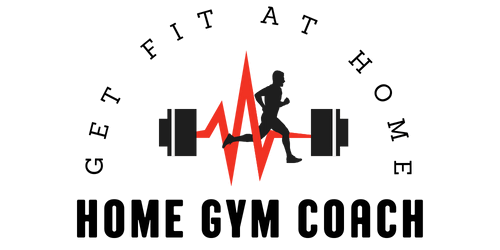Embarking on a home gym fitness journey is an incredible decision, as it allows you the convenience and comfort of working out in your own space. However, while you’re focused on reaching your fitness goals, you may find yourself wondering, “How can I effectively track my progress?” Well, fret not! In this article, we will provide you with some invaluable tips and tricks to help you seamlessly keep track of your achievements, whether it’s monitoring your weight loss, measuring your muscle gain, or tracking your overall improvement. So, get ready to conquer your fitness journey like a pro with these simple and effective tracking methods!

Setting Fitness Goals
Determining Your Fitness Goals
Setting fitness goals is an essential part of your home gym fitness journey. Before you can start tracking your progress, you need to determine what you want to achieve. Take some time to reflect on what you hope to accomplish, whether it’s losing weight, gaining muscle, improving cardiovascular endurance, or simply maintaining overall health and fitness.
Setting SMART Goals
Once you have a clear idea of your desired outcomes, it’s time to set SMART goals. SMART is an acronym that stands for Specific, Measurable, Attainable, Relevant, and Time-Bound. By following this framework, you can create goals that are realistic, actionable, and have a clear timeline for achievement. For example, instead of saying “I want to lose weight,” a SMART goal would be “I want to lose 10 pounds in three months by exercising five times a week and following a balanced diet.”
Creating a Workout Plan
With your goals in mind, it’s important to create a workout plan that aligns with your objectives. Consider the type of exercise you enjoy, whether it’s strength training, cardio, or a combination of both. Look for resources or consult with a fitness professional to design a well-rounded program that includes exercises targeting different muscle groups and provides the necessary progression for long-term success.
Scheduling Your Workouts
To stay consistent and track your progress effectively, it’s crucial to schedule your workouts in advance. Treat your exercise sessions as non-negotiable appointments with yourself, just like any other important commitment in your daily life. Find a time of day that works best for you and try to stick to it consistently. By incorporating your workouts into your routine, you’ll ensure that you have dedicated time for exercise and increase the chances of achieving your fitness goals.
Measuring Body Metrics
Tracking Body Weight
One of the most common ways to track progress is by measuring body weight. However, it’s essential to remember that weight alone does not provide a comprehensive picture of your health and fitness. Fluctuations in body weight can occur due to various factors, including water retention, muscle gain, and even time of day. To track your weight effectively, weigh yourself at the same time each day or week, ideally in the morning before eating or drinking anything. Record your measurements consistently to monitor trends over time.
Calculating Body Mass Index (BMI)
Body Mass Index (BMI) is a measurement that assesses weight relative to height and provides an estimation of body fat percentage. While it’s a helpful tool for understanding weight status, BMI has limitations and may not accurately reflect individual variations in body composition. To calculate your BMI, divide your weight in kilograms by the square of your height in meters. Keep in mind that BMI should be used as a starting point and combined with other metrics for a more complete assessment of your fitness progress.
Measuring Body Fat Percentage
For a more accurate assessment of your body composition, consider measuring your body fat percentage. There are various methods to measure body fat, including calipers, bioelectrical impedance devices, and DEXA scans. Each method has its own advantages and limitations, so choose the one that suits your needs and resources best. Remember that body fat percentage accounts for the proportion of fat mass to lean mass in your body and can provide a more detailed understanding of your progress than weight alone.
Measuring Waist Circumference
Waist circumference is another important metric to track, as it can indicate the amount of visceral fat (fat surrounding organs) you have. Visceral fat is associated with a higher risk of health conditions such as heart disease and diabetes. To measure your waist circumference, wrap a measuring tape around your waist at the level of your belly button. Keep the tape snug but not tight, and ensure it’s parallel to the floor. Record your measurements regularly to monitor changes in your waist size over time.
Taking Body Measurements
In addition to weight, BMI, body fat percentage, and waist circumference, taking body measurements can provide valuable insights into your fitness progress. Measure specific areas of your body, such as your chest, arms, waist, hips, and thighs, using a flexible tape measure. Remember to measure each area consistently, using the same landmarks for accurate comparison. Recording your body measurements regularly allows you to track changes in body composition and celebrate progress in different areas of your physique.

Keeping Workout Logs
Importance of Workout Logs
Keeping a workout log is crucial for tracking your progress in the home gym. It serves as a comprehensive record of your exercise routines, allowing you to monitor your performance, identify patterns, and make informed adjustments to your workouts. By consistently documenting your workouts, you’ll have a clear overview of your progress over time and can set realistic goals for continued improvement.
Choosing a Workout Log Method
When it comes to keeping a workout log, there are various methods to choose from. You can opt for a traditional pen and paper journal, a digital spreadsheet, or even use fitness tracking apps and devices. Select a method that suits your preferences and is easy for you to maintain consistently. Whichever method you choose, ensure it allows you to record essential details such as exercise type, sets, reps, weights, rest periods, and any additional notes you want to include.
Recording Exercise Details
To accurately track your progress, it’s essential to record the details of each exercise you perform. Include information such as the name of the exercise, the number of sets and reps you complete, and the weight or resistance used. This data allows you to monitor your strength gains and track improvements in your performance. Additionally, tracking exercise details helps you ensure proper form and technique, reducing the risk of injury and maximizing the effectiveness of your workouts.
Tracking Reps, Sets, and Weights
Tracking reps, sets, and weights is an important component of your workout log. Note down the number of repetitions completed for each set, the number of sets performed, and the weight or resistance used. This information helps you identify progress over time, as you’ll be able to see if you’re able to lift more weight, perform more reps, or complete additional sets. By tracking these measurements, you can set specific targets and strive for continuous improvement in your strength and endurance.
Noting Rest Periods and Intensity
In your workout log, don’t forget to include details about rest periods and exercise intensity. Note the duration of your rest periods, as this can impact the overall effectiveness of your workouts. Additionally, rate the perceived intensity of each exercise or workout session on a scale of 1 to 10. This subjective measure of intensity allows you to gauge the effort exerted during each session and helps you adjust your workout intensity as needed. Monitoring rest periods and intensity ensures that you’re optimizing your training and progressing toward your fitness goals.
Monitoring Heart Rate
Understanding Heart Rate Zones
Monitoring your heart rate during workouts provides insights into the intensity of your exercise and can help you optimize your training. Heart rate zones are specific ranges that represent different levels of effort and energy expenditure. The five commonly recognized heart rate zones are resting zone, fat-burning zone, cardio zone, threshold zone, and maximum effort zone. Each zone corresponds to a different percentage of your maximum heart rate and serves a specific purpose in your training program.
Measuring Resting Heart Rate (RHR)
Resting Heart Rate (RHR) refers to the number of times your heart beats per minute when at rest. Measuring your RHR regularly can provide an indication of your cardiovascular fitness and overall health. To measure your RHR, find a quiet and comfortable environment, ideally in the morning immediately upon waking up. Place your index and middle fingers on your wrist or neck to locate your pulse and count the number of beats for 60 seconds. Record your RHR consistently and track changes over time to monitor improvements in cardiovascular fitness.
Tracking Heart Rate during Workouts
During your workouts, tracking your heart rate can help you ensure that you’re exercising at the desired intensity. There are various methods to measure heart rate, including wearing a heart rate monitor or using fitness tracking devices such as smartwatches or fitness trackers. Choose the method that works best for you and provides accurate and real-time heart rate data. By monitoring your heart rate during workouts, you can adjust your effort level, maintain target heart rate zones, and maximize the effectiveness of your training sessions.
Using Heart Rate Monitors and Trackers
Heart rate monitors and trackers are valuable tools for monitoring and tracking your heart rate during workouts. These devices provide accurate real-time data, allowing you to monitor the intensity of your exercise and make necessary adjustments to your training. When choosing a heart rate monitor or tracker, consider factors such as comfort, reliability, battery life, and additional features that may be important to you, such as GPS tracking or workout analysis. Use the data provided by these devices to optimize your workouts, improve cardiovascular fitness, and track your progress over time.

Tracking Progress Photos
Importance of Progress Photos
While measuring body metrics and tracking workout logs are essential, progress photos provide a visual representation of your fitness journey. Progress photos allow you to observe changes in body composition, muscle definition, and overall appearance that are not always captured by numbers alone. By documenting your progress in photos, you’ll have a tangible reminder of how far you’ve come and the transformation you’ve achieved.
Capturing Consistent Photos
To accurately track changes in your physique over time, it’s important to capture progress photos consistently. Choose a designated spot, preferably in front of a plain background, and use the same camera or phone setup for each photo. Stand in the same position, ensure proper lighting, and maintain consistent angles and poses. By capturing consistent photos, you’ll be able to compare your progress accurately and appreciate the subtle changes that may occur throughout your fitness journey.
Choosing Proper Lighting and Angles
Lighting and angles play a crucial role in capturing accurate and informative progress photos. Choose a well-lit area with natural or indirect light that highlights your physique clearly. Avoid harsh shadows or direct light that may obscure details. Experiment with different angles to capture your body from the front, side, and back. This comprehensive approach allows you to assess changes in various areas, such as shoulder symmetry, ab definition, and overall posture. By paying attention to lighting and angles, you can ensure that your progress photos are a true reflection of your fitness journey.
Taking Front, Side, and Back Photos
When taking progress photos, it’s important to capture your body from different angles to assess changes comprehensively. Take photos from the front, side, and back to observe any changes in body composition, posture, and muscle development. When comparing these photos over time, you’ll be able to identify areas that have improved and areas that may require further focus and attention. These visual representations serve as powerful motivators and allow you to appreciate your progress beyond just numbers on a scale or measurements.
Keeping a Workout Journal
Benefits of a Workout Journal
Keeping a workout journal is a valuable tool for monitoring progress, tracking achievements, and staying accountable to your fitness goals. It provides a space to document your exercise routines, reflect on your performance, and make necessary adjustments to your training. By maintaining a workout journal, you’ll have a detailed record of your workouts, allowing you to identify patterns, measure improvements, and celebrate your achievements along the way.
Documenting Exercise Achievements
A workout journal gives you the opportunity to document your exercise achievements. Whether it’s lifting a heavier weight, completing an extra set, or running a faster mile, noting these accomplishments provides a sense of satisfaction and motivation. By recording your achievements, you’ll be able to look back and see how far you’ve progressed, reinforcing the belief in your abilities and encouraging ongoing dedication to your fitness journey.
Recording Energy Levels and Mood
In addition to tracking your physical performance, keeping a workout journal allows you to note your energy levels and mood during each workout. Record how you felt before, during, and after exercise, as well as any factors that may have influenced your mood or energy, such as sleep quality or stress levels. This information provides valuable insights into how external factors can impact your workout experience and helps you identify trends or patterns in your energy levels and mood over time.
Tracking Sleep and Recovery
Sleep and recovery play a crucial role in the effectiveness of your workouts and overall progress. In your workout journal, make a habit of tracking your sleep quality, duration, and any factors that may have influenced your rest, such as late nights or restless evenings. You can also note any recovery activities you engage in, such as stretching, foam rolling, or relaxation techniques. Monitoring sleep and recovery in your workout journal allows you to identify the impact of these factors on your performance and make adjustments to optimize your rest and recovery.
Tracking Strength and Endurance
Performing Regular Fitness Tests
Regular fitness tests are essential for tracking your strength and endurance progress accurately. These assessments provide a benchmark to measure improvements and identify areas that may require additional focus. Include exercises such as push-ups, sit-ups, planks, and cardiovascular exercises like running or cycling in your fitness tests. Perform these tests at regular intervals, such as every six weeks or monthly, to monitor your progress and adapt your workouts accordingly.
Recording Maximum Lifts and Achievements
Tracking your maximum lifts and achievements is an effective way to monitor your strength progress. Record the maximum weight you can lift for exercises such as bench press, squats, deadlifts, or any other compound movements you incorporate into your routine. Additionally, note any personal bests or milestones you achieve along the way. By documenting these accomplishments, you’ll have a reference point to compare against in the future and a record of the progress you’ve made.
Monitoring Repetitions and Endurance
Beyond tracking maximum lifts, monitoring repetitions and endurance is equally important. Note the number of repetitions you perform for each exercise and track any increases over time. This metric allows you to assess improvements in muscular endurance and track progress in exercises that require multiple repetitions, such as bodyweight exercises or dumbbell exercises. By focusing on both strength and endurance, you’ll have a well-rounded understanding of your progress and be able to set appropriate goals for continued improvement.
Tracking Cardiovascular Fitness
Cardiovascular fitness is a crucial aspect of overall health and fitness. To track improvements in your cardiovascular endurance, incorporate specific exercises or activities such as running, cycling, swimming, or jumping rope into your routine. Monitor metrics such as time, distance, or heart rate during these activities to gauge improvements over time. By tracking your cardiovascular fitness, you’ll be able to set targets, measure progress, and adjust your workouts to continuously challenge and improve your aerobic capacity.
Using Fitness Apps and Wearables
Benefits of Fitness Apps and Wearables
Fitness apps and wearables offer a range of benefits for tracking progress in your home gym fitness journey. These tools provide convenience, real-time data, and additional features that enhance your fitness experience. From tracking steps and daily activity to monitoring calorie burn and nutrition intake, fitness apps and wearables offer comprehensive tools to help you stay accountable, motivated, and informed throughout your fitness journey.
Choosing the Right App or Device
When selecting a fitness app or wearable device, consider your needs, preferences, and budget. Research different options, read reviews, and compare features to find the one that aligns with your goals. Look for apps or devices that integrate well with your home gym equipment and offer the measurements and metrics you wish to track. Whether it’s step counting, heart rate monitoring, or nutrition tracking, choose a solution that suits your requirements and simplifies the process of tracking your progress.
Monitoring Steps and Daily Activity
Fitness apps and wearables can track your steps and daily activity, allowing you to monitor your overall movement and energy expenditure. Use these tools to set daily step goals and strive for consistency in physical activity. Regular movement throughout the day contributes to overall health and can have a positive impact on weight management, cardiovascular fitness, and mental well-being. By monitoring steps and daily activity, you’ll have a clearer understanding of your overall physical engagement and can make adjustments to meet your fitness goals.
Tracking Calorie Burn and Nutrition
Many fitness apps and wearables also provide features to track calorie burn and nutrition. These tools allow you to monitor your energy intake and expenditure, providing valuable insights into your overall energy balance. Use this information to ensure you’re fueling your body adequately while aligning with your goals, whether it’s weight loss, muscle gain, or weight maintenance. Tracking calorie burn and nutrition can help you make informed choices about your diet, optimize your workouts, and maintain balance in your overall fitness journey.
Syncing Data with Home Gym Equipment
Some fitness apps and wearables offer the ability to sync data with your home gym equipment, providing a seamless integration of tracking and monitoring. This feature allows you to access real-time data on your workout equipment’s screen, eliminating the need to switch between devices or manually input information. Syncing data provides convenience, accuracy, and a streamlined experience, ensuring that you have all the necessary information to track your progress right at your fingertips.
Hiring a Personal Trainer
Benefits of Hiring a Personal Trainer
While tracking progress on your own is possible, hiring a personal trainer can provide numerous benefits for your home gym fitness journey. A personal trainer brings expertise, accountability, and personalized guidance to help you reach your fitness goals more efficiently and effectively. They can design customized workout programs, ensure proper form and technique, and provide ongoing support and motivation throughout your fitness journey.
Setting Clear Fitness Goals
One of the primary advantages of working with a personal trainer is their ability to help you set clear and realistic fitness goals. They will take the time to understand your objectives, assess your current fitness level, and create a plan that aligns with your aspirations. With their expertise and experience, personal trainers can set challenging yet achievable goals that consider your individual abilities, preferences, and limitations.
Getting Personalized Workout Programs
Personal trainers are skilled at designing personalized workout programs tailored to your specific needs and goals. They will consider factors such as your fitness level, any existing health conditions, time constraints, and equipment availability to create a plan that optimizes your progress. Personalized workout programs ensure that you’re performing exercises that are appropriate for your abilities, minimize the risk of injury, and maximize the effectiveness of each session.
Receiving Expert Guidance and Feedback
Working with a personal trainer provides you with expert guidance and feedback on your technique, form, and progress. They will observe your exercises, correct any errors, and provide valuable insights to enhance your workouts. Personal trainers have a wealth of knowledge about exercise physiology, biomechanics, and training principles, allowing them to provide accurate and evidence-based feedback. This guidance ensures that you’re performing exercises safely and efficiently, accelerating your progress and minimizing the risk of injury.
Reevaluating and Adjusting
Reflecting on Your Progress
Throughout your home gym fitness journey, it’s essential to take time for self-reflection and evaluate your progress. Regularly assess your achievements, setbacks, and areas for improvement. Reflect on the goals you set initially and determine if they still align with your aspirations. Celebrate your successes and acknowledge your hard work and dedication. By reflecting on your progress, you’ll gain a renewed sense of motivation and commitment to your fitness goals.
Identifying Strengths and Weaknesses
As you evaluate your progress, identify your strengths and weaknesses in different areas of your fitness journey. Recognize the exercises or activities in which you excel and the ones that require more attention or improvement. By understanding your strengths, you can continue to build upon them and strive for excellence. Identifying weaknesses allows you to develop targeted strategies to address those areas and ensure a well-rounded fitness routine.
Adjusting Fitness Goals and Strategies
Throughout your fitness journey, it’s natural for goals and strategies to evolve. As you progress and gain more knowledge, you may find that your initial goals no longer align with your current aspirations. Be open to adjusting your fitness goals and strategies based on your newfound insights and experiences. Personal growth is a continuous process, and adapting your goals and strategies ensures that you’re always working towards what truly matters to you.
Seeking Support and Guidance
Remember that your home gym fitness journey is not a solo endeavor. Seek support and guidance from professionals, friends, or online communities. Surround yourself with individuals who uplift and motivate you, providing insights and encouragement along the way. Engaging with others who share similar goals can inspire and challenge you to push yourself further. Embrace the support system available to you and build connections that effortlessly integrate into your fitness routine.
In conclusion, tracking your progress in your home gym fitness journey is crucial to staying on track and achieving your goals. By setting clear fitness goals, measuring body metrics, keeping workout logs, monitoring heart rate, tracking progress photos, maintaining a workout journal, and utilizing fitness apps and wearables, you can maximize your progress and ensure long-term success. Additionally, considering the benefits of hiring a personal trainer and regularly reevaluating and adjusting your goals and strategies provide valuable insights and guidance throughout your fitness journey. Remember, your fitness journey is unique, and tracking your progress allows you to celebrate accomplishments, identify areas for improvement, and stay committed to a healthier and fitter version of yourself.


